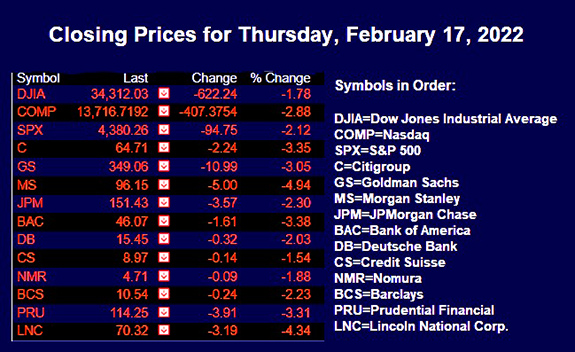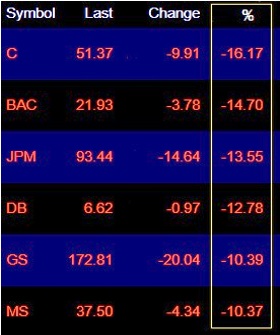SUBCRIBE TO THIS DAILY NEWSLETTER TO FOLLOW WALL STREET AND THE FEDERAL RESERVE
Banks Sink – Throwing More Cold Water on All That Talk that Megabanks Are a Great Investment
By Pam Martens and Russ Martens: February 18, 2022 ~
There are apparently stock-picking analysts across Wall Street pumping out buy recommendations on stocks to the public who have never cast their eyes on those chilling derivative charts published quarterly by the Office of the Comptroller of the Currency. If the analysts had cast their eyes on those charts, the last thing they would be recommending right now are megabank stocks. We’re talking specifically about JPMorgan Chase, Goldman Sachs, Citigroup, Bank of America and Morgan Stanley, which, together, control approximately 90 percent of the hundreds of trillions of dollars (notional/face amount) in derivatives held by all 4,900 banks and bank holding companies in the U.S.
We’re also talking about the foreign banks that are significant derivative counterparties to these and other banks — such as Deutsche Bank, Credit Suisse, Nomura and Barclays.
The chart above shows how these banks performed yesterday compared to the major stock averages. Citigroup, Goldman Sachs and Bank of America were all down more than 3 percent while Morgan Stanley was down almost 5 percent – in one trading session. (Morgan Stanley may have exceeded the declines in other bank stocks because in addition to having a powder keg full of derivatives, it has been named in the press as a central figure in a Justice Department probe involving potential leaks of information to hedge funds.)
We’ve also added two insurance companies to the above chart: Prudential Financial and Lincoln National. Both were named in a previous Office of Financial Research (OFR) report as serving as counterparties to derivative trades on Wall Street.
For how the megabanks and insurers performed during the market selloff in March of 2020, see our report: There Was a Bloodbath in Wall Street Banks and Insurers Yesterday.
Despite the crystal-clear writing on the wall, analysts across Wall Street are still recommending megabank stocks to the public. Consider this report that appeared in Barron’s on February 1. It cites analysts at Piper Sandler recommending Bank of America and Goldman Sachs, and it adds this:
“Broadly speaking, the banking sector looks strong. It emerged from the pandemic unscathed, and the recovery — coupled with the Federal Reserve lifting interest rates — should boost banks’ bottom lines.”
Unscathed? Seriously? Consider the chart below which reflects the closing prices of the megabanks on March 9, 2020. In just one trading session Citigroup lost over 16 percent; Bank of America lost more than 14 percent; JPMorgan Chase lost over 13 percent and Deutsche Bank was down over 12 percent.
The megabanks survived the pandemic because the Fed pumped trillions of dollars in cumulative repo loans into these megabanks from September 17, 2019 through at least July 2, 2020. At that point, the Fed had multiple other bailout programs for the banks in operation. See our report: The Fed Has Pumped $9 Trillion into Wall Street Over the Past Six Months, But Mnuchin Says “This Isn’t Like the Financial Crisis.”
It’s also a complete fallacy that rising interest rates are good for the megabanks. What rising interest rates do is to accelerate all of the myriad forms of credit risks that reside in these banks: inadequate loan loss reserves; opaque derivative contracts with dubious counterparties; highly-leveraged loans with borrowers that suffer credit downgrades during a rising-interest rate environment, and so on.
Despite this reality, the Wall Street Journal reports that 16 analysts have buy ratings on Citigroup; 16 analysts also have buy ratings on Goldman Sachs; 15 have buy ratings on Morgan Stanley; 14 analysts have buy ratings on Bank of America; and 12 analysts have buy ratings on JPMorgan Chase.
Analysts are simply not this stupid or uninformed. The only possible explanation is that the same level of corruption that was prevalent during the research and analyst scandals of the dot.com era has once again enveloped Wall Street.
Caveat emptor – let the buyer beware.



No comments:
Post a Comment
Note: Only a member of this blog may post a comment.